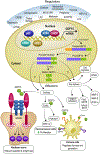GDF15: a potential therapeutic target for type 1 diabetes
- PMID: 35138971
- PMCID: PMC8885880
- DOI: 10.1080/14728222.2022.2029410
GDF15: a potential therapeutic target for type 1 diabetes
Abstract
Introduction: Current treatment for type 1 diabetes (T1D) is centered around insulin supplementation to manage the effects of pancreatic β cell loss. GDF15 is a potential preventative therapy against T1D progression that could work to curb increasing disease incidence.
Areas covered: This paper discusses the known actions of GDF15, a pleiotropic protein with metabolic, feeding, and immunomodulatory effects, connecting them to highlight the open opportunities for future research. The role of GDF15 in the prevention of insulitis and protection of pancreatic β cells against pro-inflammatory cytokine-mediated cellular stress are examined and the pharmacological promise of GDF15 and critical areas of future research are discussed.
Expert opinion: GDF15 shows promise as a potential intervention but requires further development. Preclinical studies have shown poor efficacy, but this result may be confounded by the measurement of gross GDF15 instead of the active form. Additionally, the effect of GDF15 in the induction of anorexia and nausea-like behavior and short-half-life present significant challenges to its deployment, but a systems pharmacology approach paired with chronotherapy may provide a possible solution to therapy for this currently unpreventable disease.
Keywords: ER stress; GDF15; immunomodulator & chronotherapy; insulitis; type 1 diabetes (T1D); type 2 diabetes (T2D); β cells stress.
Conflict of interest statement
Declaration of interest
The authors have no relevant affiliations or financial involvement with any organization or entity with a financial interest in or financial conflict with the subject matter or materials discussed in the manuscript. This includes employment, consultancies, honoraria, stock ownership or options, expert testimony, grants or patents received or pending, or royalties.
Figures



Similar articles
-
Metformin and growth differentiation factor 15 (GDF15) in type 2 diabetes mellitus: A hidden treasure.J Diabetes. 2022 Dec;14(12):806-814. doi: 10.1111/1753-0407.13334. Epub 2022 Nov 28. J Diabetes. 2022. PMID: 36444166 Free PMC article. Review.
-
Secreted GDF15 maintains transcriptional responses during DNA damage-mediated senescence in human beta cells.Am J Physiol Endocrinol Metab. 2024 Oct 1;327(4):E552-E562. doi: 10.1152/ajpendo.00257.2024. Epub 2024 Aug 28. Am J Physiol Endocrinol Metab. 2024. PMID: 39196800
-
NAG-1/GDF15 protects against streptozotocin-induced type 1 diabetes by inhibiting apoptosis, preserving beta-cell function, and suppressing inflammation in pancreatic islets.Mol Cell Endocrinol. 2022 Jun 1;549:111643. doi: 10.1016/j.mce.2022.111643. Epub 2022 Apr 6. Mol Cell Endocrinol. 2022. PMID: 35398052
-
Comprehensive Proteomics Analysis of Stressed Human Islets Identifies GDF15 as a Target for Type 1 Diabetes Intervention.Cell Metab. 2020 Feb 4;31(2):363-374.e6. doi: 10.1016/j.cmet.2019.12.005. Epub 2020 Jan 9. Cell Metab. 2020. PMID: 31928885 Free PMC article.
-
Vitamin D and diabetes.Endocrinol Metab Clin North Am. 2010 Jun;39(2):419-46, table of contents. doi: 10.1016/j.ecl.2010.02.013. Endocrinol Metab Clin North Am. 2010. PMID: 20511061 Review.
Cited by
-
A Single-Cell Survey of Cellular Heterogeneity in Human Great Saphenous Veins.Cells. 2022 Aug 31;11(17):2711. doi: 10.3390/cells11172711. Cells. 2022. PMID: 36078120 Free PMC article.
-
GDF15: An emerging disease target and biomarker of metabolic diseases.J Endocrinol Invest. 2025 Jun 26. doi: 10.1007/s40618-025-02636-y. Online ahead of print. J Endocrinol Invest. 2025. PMID: 40569532 Review.
-
Metformin and growth differentiation factor 15 (GDF15) in type 2 diabetes mellitus: A hidden treasure.J Diabetes. 2022 Dec;14(12):806-814. doi: 10.1111/1753-0407.13334. Epub 2022 Nov 28. J Diabetes. 2022. PMID: 36444166 Free PMC article. Review.
-
GDF-15 and mtDNA Deletions Are Useful Biomarkers of Mitochondrial Dysfunction in Insulin Resistance and PCOS.Int J Mol Sci. 2024 Oct 10;25(20):10916. doi: 10.3390/ijms252010916. Int J Mol Sci. 2024. PMID: 39456699 Free PMC article.
-
Metformin Effects on SHIP2, AMPKs and Gut Microbiota: Recent Updates on Pharmacology.Curr Med Chem. 2025;32(9):1732-1754. doi: 10.2174/0109298673289342240213040144. Curr Med Chem. 2025. PMID: 38409699 Review.
References
-
- Federation ID. IDF diabetes atlas ninth. Dunia: IDF. 2019.
-
- Hermann R, Knip M, Veijola R, et al. Temporal changes in the frequencies of HLA genotypes in patients with Type 1 diabetes—indication of an increased environmental pressure? Diabetologia. 2003;46(3):420–425. - PubMed
-
- Eisenbarth GS. Type I diabetes mellitus. New England journal of medicine. 1986;314(21):1360–1368. - PubMed
Publication types
MeSH terms
Substances
Grants and funding
LinkOut - more resources
Full Text Sources
Other Literature Sources
Medical
